■ Xiao Xi / Text
Many people know about the connection between the Internet and high-energy physics. In the late 1980s, several large-scale high-energy physics experiments were being conducted at the European Organization for Nuclear Research (CERN), involving hundreds of scientists from dozens of countries. To facilitate their work, there was an urgent need for an information management and transmission system that could quickly, accurately, and conveniently exchange massive amounts of data over long distances. Tim Berners-Lee, a British scientist working at CERN, came up with a solution by using the “Hypertext Transfer Protocol” to create an internal network at CERN (the World Wide Web). Since 1991, this Internet technology has been widely used internationally, and today at least 3.5 billion people worldwide use the Internet (about half of the global population).
However, many people are unaware that another high-tech marvel—the touchscreen—also has historical ties to high-energy physics.
In recent years, touchscreens have permeated nearly every field and are closely related to almost everyone: GPS systems, various control panels, ATM machines, cash registers, vending machines, ticket machines, medical monitors, gaming consoles, computers, smartphones… this technology is almost everywhere.
What is the connection between it and high-energy physics? Let’s look at the related story.

Decades ago, the most imaginative science fiction writers had not even conceived of the touchscreen. Even more surprising is that the touchscreen technology, born in the 1960s and 70s, has developed at an astonishing speed into an omnipresent daily technology, sweeping the globe. Looking back at its development history, some facts are indeed little known.
■ E.A. Johnson
It is generally believed that E.A. Johnson from the Royal Radar Establishment in Malvern, England, was the first to propose the concept of touch display. In 1965, Johnson published a brief paper in the journal Electronics Letters titled “Touch Display: A Novel Input/Output Device for Computers”, in which he proposed the idea of a touch display as an input/output device: touching a composite glass screen (coated on the inner surface with a transparent metal oxide layer such as Indium Tin Oxide (ITO), with four electrodes at the corners) generates an induced electrostatic capacitance, and the measurement of capacitance changes is used to calculate the touch actions on the glass screen (later known as capacitive touch screens).

E.A. Johnson (Image from the Internet)
In 1967, Johnson turned his idea into reality by creating the world’s first touchscreen. He published a paper titled “Touch Displays: A Programmed Man-Machine Interface” in the journal Ergonomics, which included a photo and schematic of the first touchscreen. Johnson’s invention was awarded a US patent in 1969 (US patent 3482241).

The first touchscreen made by Johnson in 1967 (Image from the Internet)
This screen, although somewhat bulky, could display magical effects: wherever the finger touched, the screen would light up at that point and record the finger’s position. At that time, the invention could only provide the location of a single finger touch; if there were multiple contacts on the screen, the controller’s calculations would become confused, and the screen could only register whether there was contact or not, without sensing the pressure of the touch.
In 1973, this touchscreen technology was used by the British Civil Aviation Authority for air traffic control systems (which only required precise positioning) and was continuously improved until the late 1990s.
■ George Samuel Hurst
Most articles in the media that introduce the history of touchscreen development jump directly from Johnson’s successful creation of the first capacitive touchscreen in 1967 to George Samuel Hurst in the United States, who invented a more sensitive and intelligent resistive touchscreen a few years later.
At that time, Hurst was teaching at the University of Kentucky, leading a team using an old Van de Graaff electrostatic accelerator (which generates high voltage to accelerate charged particles) that could only work at night to study atomic physics. They needed to stay up all night in front of a fluorescent screen, recording the positions of the light spots caused by charged particles hitting the screen.
Hurst felt that this recording method was too time-consuming, tedious, and cumbersome. What to do? One day, he suddenly got an idea to solve the problem: to place a conductive plate in front of the accelerator to collect the emitted charged particles, using electrodes around the conductive plate to read the X-Y coordinate information that determined the particle positions, which was both efficient and accurate. This touch sensor could input data quickly, completing calculations that originally took days in just a few hours. However, this device did not have a transparent screen and was quite large.
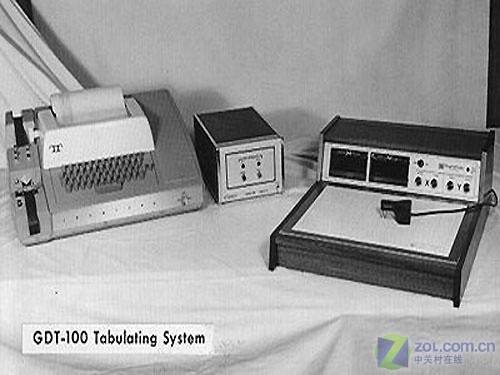
George Samuel Hurst (Image from the Internet)
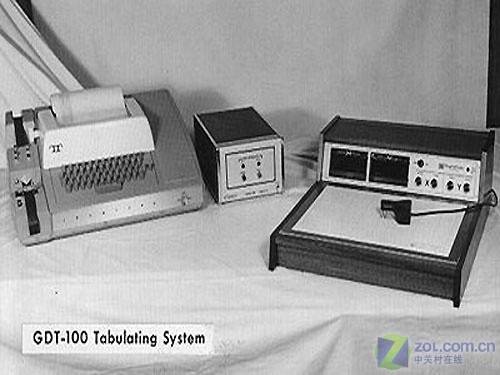
The touch sensor invented by Hurst (Image from the Internet)
The University of Kentucky hoped Hurst would apply for a patent for this, but he thought it was too limited in application to meet the patent standards, so he began to think about how to promote this method for other uses.
In 1970, Hurst came to work at the Oak Ridge National Laboratory (ORNL) in the United States, inviting several friends from different fields to research this matter together in his basement during their spare time. The initial idea was: it would be great if they could install a touchscreen on a computer monitor to interact with the computer.
They used the same Indium Tin Oxide (ITO) metal coating as Johnson’s capacitive touchscreen, but cleverly applied this layer of metal to the back of a pressure-sensitive film. When a finger or a plastic pen touched the film, the metal coating at that position would contact the conductive plate behind it, thus allowing current to flow. The conductive plate was laid out with X-Y coordinate axes, which could accurately record the current’s position and distinguish different pressures of touch.
In 1971, they applied for a patent for the resistive touchscreen and co-founded the company “Elographics”. The members were responsible for sensors, conductive plates, and calculator programming, and ultimately assembled the products in Hurst’s basement. From May to December of that year, they manufactured 25 completed touchscreen units, named “E-100”. In 1973, this technology was selected as one of the 100 most important new technological products of the year by Industrial Research magazine in the United States.

The E-100 touchscreen in use (Image from the Internet)
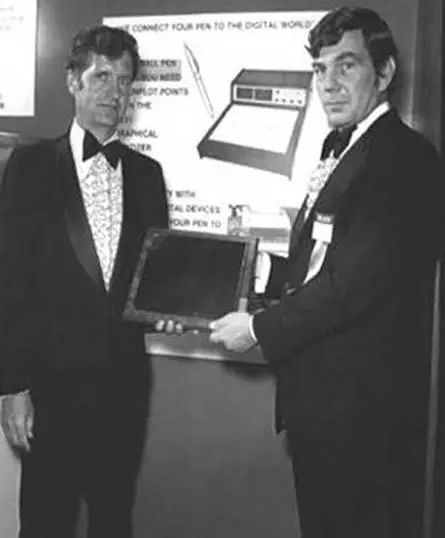
Hurst (left) receiving the 1973 New Technology Product Award as a company representative (Image from the Internet)
In 1974, Hurst designed the first transparent resistive touchscreen and continued to refine the related technology. During this period, the technology was mainly monopolized by the U.S. military. It wasn’t until 1982, when Hurst’s company exhibited 33 televisions equipped with resistive touchscreens at an electronics exhibition in the U.S., that this technology truly entered commercial use.
Bent Stumpe & Frank Beck
The contributions of Johnson and Hurst to the invention of touchscreens have left a significant mark in the history of touchscreen development, and Hurst is even referred to as the father of touchscreens. However, another story about touchscreens in the early 1970s has been overlooked by many; some sources simply mention, “Two engineers from CERN invented the transparent touchscreen.”

The history of touchscreen development in the media overlooks an important part (Image from the Internet)
What story is there? After some searching, I finally found reliable information:
An article titled “The First Capacitative Touch Screens at CERN” published in CERN’s publication CERN COURIER on March 31, 2010, as well as the document “Another of CERN’s Many Inventions” in CERN’s archives, provide a detailed introduction to this process.
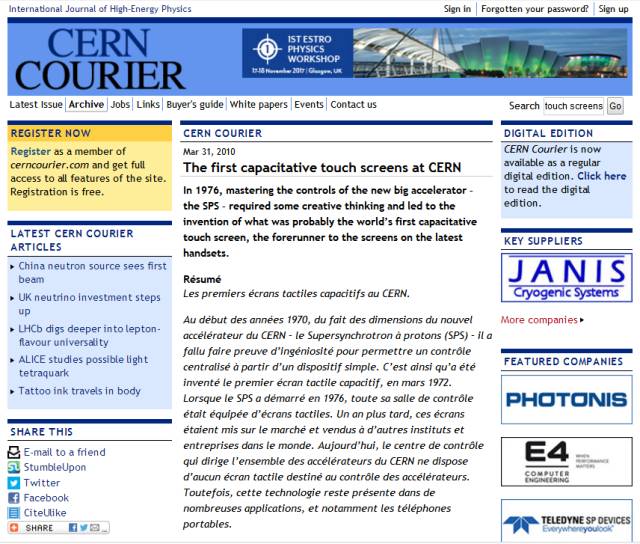
The first capacitative touch screens at CERN (Image from the Internet)

Another of CERN’s Many Inventions (Image from the Internet)
In February 1971, CERN began construction of the Super Proton Synchrotron (SPS), with a circumference of nearly 7 kilometers, making it about ten times the size of the Proton Synchrotron (PS) that began operating in 1959. For the SPS, if the same control method used for the PS were adopted, thousands of various buttons, knobs, switches, and oscilloscopes would need to be installed in its central control room, and all equipment would be directly connected to the central control room via a single cable, which was completely impractical economically.

Schematic diagram of the Proton Synchrotron PS and Super Proton Synchrotron SPS (Image from the Internet)
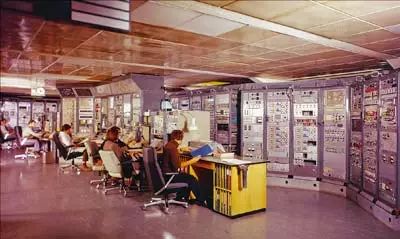
Control room of the Proton Synchrotron PS (1974) (Image from the Internet)
According to the design, various devices of the SPS would be controlled via three control consoles, each equipped with its own small computer. The new central control room needed to consolidate the information from the three consoles and had to control thousands of parameters of the accelerator with a small number of knobs, switches, and displays. One of the primary tasks facing the SPS control team in early 1972 was to find a practical and economical solution to this problem.
At that time, Frank Beck was the head of the SPS central control room, and Bent Stumpe was an engineer from Denmark (who had previously worked in a television factory and had rich practical experience). Beck posed the question to Stumpe: How could they construct a hardware system with intelligence to replace all the traditional buttons and switches on the three control consoles?

Frank Beck (left) (Image from the Internet)
A few days later (March 11, 1972), Stumpe proposed a solution (written in a notebook)—to develop a capacitive touchscreen as an interactive computer display for the SPS central control room, displaying a fixed number of programmable buttons. Each programmable button was associated with a capacitor formed by fine copper wires etched on the glass membrane. When a person’s finger touched a programmable button on the glass screen, the corresponding capacitance would increase by 10%, and specialized electronic devices would record these changes, leading to a new set of labels, i.e., the next set of new commands available for the user to choose from.

Stumpe’s handwritten notes on the proposed solution (16 pages) (Image from the Internet)
These programmable buttons, along with a trackball (which identifies X-Y movements through the ball’s rolling, moving the pointer on the screen similarly to a computer mouse), and a programmable rotary switch, could form an “intelligent” control system based on a small computer, replacing the thousands of buttons, switches, and oscilloscopes required by traditional control systems (this idea became feasible only after the development of computer-supported central control systems).
According to Stumpe’s later recollections, CERN had the ion sputtering technology at that time, which allowed a thin layer of copper to be evaporated onto a sensitive and transparent polyester film, thus realizing the idea of capacitors formed by fine copper wires, leading to the production of the first prototype of a capacitive touchscreen. A touchscreen with nine programmable buttons could actually work, reliably recognizing when a user touched a button. Beck presented this prototype to the SPS leaders, who immediately supported further research and development by Stumpe and others, even deciding to start research on the corresponding computer control software before reliable testing had been conducted, which was a significant risk at the time.
To further develop a practical touchscreen (with 16 programmable buttons), Stumpe and others collaborated with the Danish company FERROPERM, ultimately using a more robust glass screen (reducing surface reflection), while another Danish company, NESELCO, participated in the production of the electronic modules required to drive the touchscreen.
Initially, the touchscreen had only 16 fixed programmable buttons, each associated with different areas of the screen. Later, Stumpe further expanded his original concept, envisioning the development of an X-Y touchscreen that could sense positions corresponding to X and Y coordinates through two layers of capacitors, which provided greater flexibility in dividing the screen. The X-Y touchscreen also involved new technology for plating metal films on different substrates. After completing the prototype, CERN collaborated with other units to develop the product with funding from the Danish National Development Fund.
The SPS began operation in June 1976, equipped with touchscreens in its control room—this was the world’s first large device to use this capacitive touchscreen technology. These touchscreens were also employed in other large devices and modern control systems for larger particle colliders. Remarkably, some of the touchscreens operated for 20-30 years until 2008, when CERN installed new control rooms for the larger Large Hadron Collider (LHC).
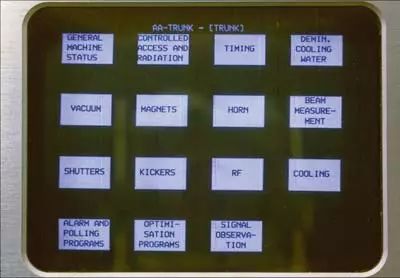
The touchscreen with 16 programmable control buttons (Image from the Internet)
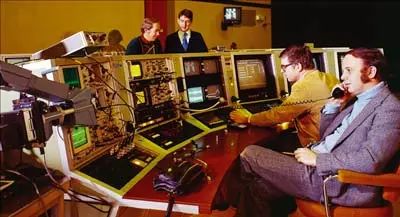
The control room of the Super Proton Synchrotron SPS (1977) (Image from the Internet)
The capacitive touchscreen in the SPS control room (video from CERN’s official website)

Stumpe with the touchscreen he invented (Image from the Internet)
This touchscreen technology was commercially applied in 1977 and was sold to other users at CERN, other research institutions, and companies wishing to use this technology in their control systems. Users of this touchscreen technology are spread across the globe: on jet aircraft, at the Rutherford Laboratory in the UK, at the KEK High Energy Accelerator Research Organization in Japan, Mitsubishi Corporation in Japan, Toyota, and various institutions in Denmark and Germany…
Note: After Steve Jobs returned to Apple in 1997, he ultimately decided to use capacitive touchscreen technology (which was still cutting-edge technology at the time) in the development of the iPhone. Compared to the resistive touchscreens prevalent in the market at that time, capacitive touchscreens had significant advantages. Resistive touchscreens required pressure from a finger or a special stylus to activate, and the top film had to be thin enough to meet the elastic requirements for touching the lower film. The film was prone to damage. In contrast, capacitive touchscreens only required a touch to generate a signal without the need for pressure, and they were protected by a glass layer, making them highly resistant to damage and contamination. At this time, capacitive touchscreen technology had evolved from early analog touchscreens to digital touchscreens, enabling multi-touch capabilities, providing new opportunities for developing smartphone software. Jobs not only successfully transformed a near-bankrupt company into a giant in the consumer electronics industry but also brought touchscreens into the daily lives of the public.
■ Conclusion
With the continuous development of technology, touchscreens have become increasingly adept at accepting touches and recognizing gestures, achieving ultra-efficient human-computer interaction and finding broader applications in more fields. Today, touchscreen technology has permeated nearly every field and is closely related to almost everyone: GPS systems, various control panels, ATM machines, cash registers, vending machines, ticket machines, medical monitors, gaming consoles, computers, smartphones… this technology is almost everywhere.

Ubiquitous touchscreens (Image from the Internet)
From the information presented above, the connection between touchscreen technology and high-energy physics is quite clear.
It should be said that high-energy physics has always been an incubator for the development of innovative technologies, spawning a large number of high-tech advancements over the decades. These technologies were initially developed to solve internal problems of large experimental devices required for high-energy physics research. Ultimately, these technologies greatly promoted the development of science and the economy, benefiting all of humanity.
Reflecting on the story of CERN developing touchscreens is thought-provoking, and the contributions of Stumpe and Beck should not be forgotten; this experience should be prominently recorded in the history of touchscreen development.
References
1. Let’s Unveil the Mystery of Touch Technology!
http://www.elecfans.com/consume/402298.html
2. Ding Junjun, Xu Guoxiang, Chen Yuhua, Tian Minli, Overview of Capacitive Touchscreen Patent Technology, Chinese Science and Technology Information 2014, No. 10, http://www.doc88.com/p-0691399543686.html
3. Touchscreens Everywhere: A 3-Minute Overview of Touchscreen Development History http://www.sohu.com/a/140546126_732542
4. The Great Touchscreen: Leading Science Fiction by Twenty Years! http://news.zol.com.cn/605/6055213.html
5. The Father of Touchscreens: A Historical Review of Inventions, http://digi.tech.qq.com/a/20080902/000107.htm
6. iPhone: One General’s Success Comes at the Expense of Many, Big Technology Magazine, http://www.sohu.com/a/199269688_418353
7. Sam Hurst Touch, http://www.physics.berea.edu/documents/SamHurst.pdf
8. IET Digital Library: Touch Display—A Novel Input/Output Device for Computers
http://digital-library.theiet.org/content/journals/10.1049/el_19650200
9. Touch Displays: A Programmed Man-Machine Interface
http://www.tandfonline.com/doi/pdf/10.1080/00140136708930868?needAccess=true
10. Another of CERN’s Many Inventions!
http://cds.cern.ch/record/1248908
11. Frank Beck, Bent Stumpe, Two Devices for Operator Interaction in the Central Control of the New CERN Accelerator (Report), CERN, May 24, 1973
12. “The First Capacitative Touch Screens at CERN”. CERN Courier. March 31, 2010
http://cerncourier.com/cws/article/cern/42092
13. The Touching History of Touchscreen Tech
http://mashable.com/2012/11/09/touchscreen-history/#QjTLzvd2csqp
14. From Touch Displays to the Surface: A Brief History of Touchscreen Technology
https://arstechnica.com/gadgets/2013/04/from-touch-displays-to-the-surface-a-brief-history-of-touchscreen-technology/
15. CERN Touch Screen
https://www.symmetrymagazine.org/article/june-2010/cern-touch-screen
16. Six Stories Behind Touchscreens: How Steve Jobs Revived Its Fate
http://www.21ic.com/news/ce/240498.htm

This article is reproduced with permission from the WeChat public account of the Institute of High Energy Physics, Chinese Academy of Sciences
1. Five Contributions of Mr. Yang Zhenning After His Return || Zhu Bangfen
2. Theoretical Structure Prediction Based on Intelligent Global Optimization Algorithm | Video
3. Application of Machine Learning Methods in Quantum Many-Body Physics
4. Application of Deep Learning in High Energy Physics
5. Astronomy in the Information Age || Video
6. The Computer’s Ability to Handle the Complexity of Go Surpasses Humans || Video
7. Superconductors: The 23rd Time of the “Hour of Superconductivity”
8. A Close Reading of the Names of Chemical Elements in Physics
9. Just Now, Gravitational Wave Detection Wins the 2017 Nobel Prize in Physics
10. Just Now, LIGO Jointly Released an Unprecedented Major News with Global Astronomy Research Institutions!
END

For more exciting articles, please follow the WeChat account: cpsjournals

